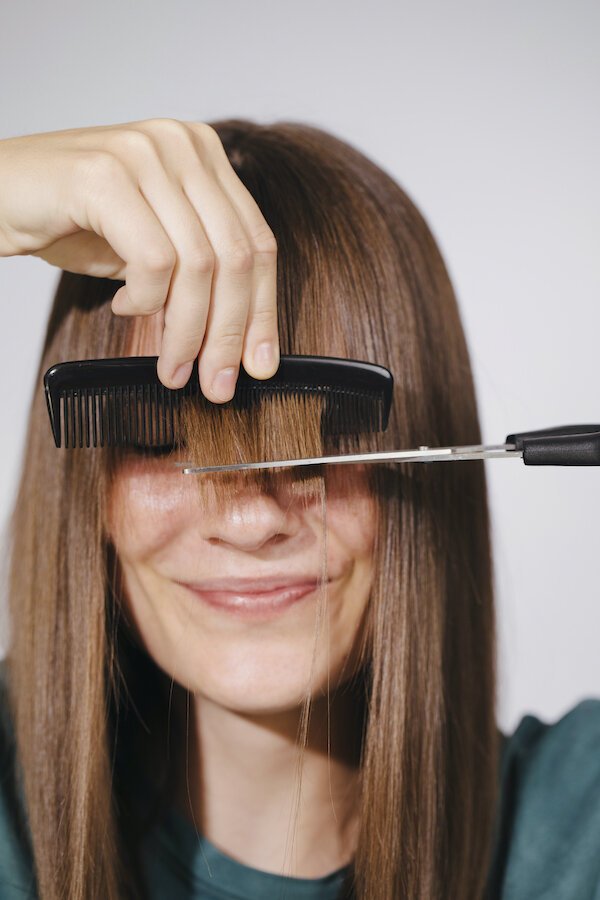
How To Cut Your Own Hair At Home (Easy Tutorial)
A DIY Hairdo
I started cutting my own hair over a decade ago. It hasn’t always been perfect—and yes, I have had several unintentional mullets—but it’s something I genuinely enjoy doing for myself. As COVID has put restrictions on salons, my years of self-styling have been put to good use. But what if you’ve never embarked on cutting your own hair before?
Below, I’m sharing some of my tips from personal experience. But, I’m also entirely self-taught, which is why I reached out to Kayla Lofaro, a licensed hair stylist for over 14 years and founder of the new (dreamy) salon Discotheque in Silver Lake, Los Angeles. There’s a good reason that styling is a career and art form because—as you’ll read below—doing it yourself isn’t likely going to give you a red carpet-worthy cut or color.
Ready (and willing) to give a home haircut a try? Here’s how to get started.
Manage Your Expectations
“Consider first how much your hair means to you—for some people, it is figuratively (or literally) sacred.”
Speaking from experience, it’s important to embrace humility and humor when cutting your own hair. I look back at old photos and wonder why my friends didn’t tell me I had a mullet (although, nowadays, they’re in style?). Sometimes I come across photos from the time I messed up a pixie cut beyond repair and solved it by shaving my whole head to a fuzzy 1-inch length.
If you want a drastic change, I suggest two options: see a professional or prepare yourself for the worst-case scenario. Consider first how much your hair means to you—for some people, it is figuratively (or literally) sacred. For others, like me, it’s a mild inconvenience that will always grow back. But if you’ll be devastated if something goes wrong, put down the shears and set an appointment.
Watch, Research, Experiment
Before you start, decide exactly what you want to do with your hair. Going into a DIY haircut without a plan is precisely how I ended up with two shaved sides and a long-on-top look for several years. Can we talk about how difficult that is to grow out? (No—there’s simply not enough time.)
Save Instagram posts and Pinterest inspiration to identify your desired style, and pay close attention to style names so you can search for specific tutorials later. Again, get a feel for the complexity of the cut you’re hoping to achieve and weigh that against your abilities. Maybe you’ll find that a professional could do it more skillfully.
“Get a feel for the complexity of the cut you’re hoping to achieve and weigh that against your abilities.”
From there, watch a wide range of YouTube videos that feature people with the same type of hair as you. My hair is thick with a slight wave, which is why my occasional spontaneous “I should try straight bangs again” always ends in disappointment and a side-part. But don’t just watch one video and start hacking away—I’ve found it’s best to watch a few tutorials to get a beginner’s grasp on the techniques.
Here are a few from the professionals to get you started:
Beauty Cutright on cutting shorter natural hair
Beauty Insider on how to cut curly hair yourself
Ellebangs gives tips on not botching an at-home haircut
Jamie Swan’s blunt, angled bob
Manes By Mell trimming curly hair at home
Pick Up Limes cut & layer for long hair
Stella Cini’s non-tutorial follow-along of a stylist’s video
And know that not every method will be a winner for your hair type. The “unicorn method,” where you trim the end of a ponytail that’s tied on the top of your head, wasn’t particularly magical for me. It might be for you!
Gather The Right Tools
“Keep the kitchen scissors in the kitchen, please,” emphasizes Lofaro. Crafting shears or a dull pair of kids’ safety scissors won’t cut it either (literally). Instead, reserve a pair of professional styling shears just for hair cuts—you can find them online or at your local drugstore. Note that they can be extremely sharp, so proceed with caution!
“Reserve a pair of professional styling shears just for hair cuts.”
Lofaro also suggests having a double-edged comb (one side with wide teeth, the other with fine teeth) to section off your hair and clips to hold each section. I’ve made do with a handful of hair elastics, but actual clips would be a game-changer—consider them added to my shopping list.
Be intentional about how you set up your space, too. “Make sure the lighting is right and bright,” Lofaro recommends, noting that you can use a ring light in dim settings. I also keep a hand mirror close by to easily see the back and sides of my hair.
Advice For The Process
Before you make the first cut, spend some time getting a feel for the texture and weight of your hair when dry. Any split ends? Is it weighed down with product? Are you consolidating or creating layers? (Think of it almost as a sensory meditation; I just always find it helpful to check in on how my hair is changing, especially as I age). Then, give it a wash.
“You could cut it wet or dry, it depends on your preference,” says Lofaro. “But dry cuts are best for layers, curls or waves. Wet cuts are good for blunt, straight edges.”
“Before you make the first cut, spend some time getting a feel for the texture and weight of your hair when dry.”
I prefer wet cuts to start and then apply finishing touches throughout the week on dry hair—that’s right, I said week. My haircuts take more than one day to complete because stray strands always reveal themselves after the first wash. Again, if you need a perfect haircut, book a stylist! Otherwise, have patience (and remember how I mentioned a sense of humor? 🤪).
Segment your hair and cut slowly, pausing to take breaks, to brush out your hair, or to restart the YouTube tutorial. Large cuts are therapeutic but chaotic, so aim to cut less than you think you might need to. Not all cuts are straight and flat, either—pay close attention to your scissor techniques and how the professionals cut in videos. For my short pixie, I hold my hair out 90 degrees and cut it upwards. For bangs, I comb the hair flat down and finalize with small, upward snips called “point cuts” (versus a blunt, and often uneven, straight across chop).
For the sake of clean-up, I recommend a hand vacuum or broom (don’t let your hair go down the sink if you’re cutting a lot of it) and wearing either a button-down shirt or just a sports bra. The last thing you want to do is peel a crew neck off after you’re done and get a mouthful of hair trimmings—I promise you. I pop myself straight into the shower after a cut and find that it takes a couple of washes before my body is free of scratchy loose hairs.
“One of the main reasons I’ve continued to cut my own hair is because the process is fun, embodying, and exercises the problem-solving part of my brain.”
Oh, and, tempting as it may seem, save the adult beverage for your post-COVID spa day. No one needs cloudy judgment when you’re the one holding the scissors.
If the idea of cutting your hair feels overwhelming or terrifying, I have two words for you: messy bun. You don’t have to do this if you don’t want to! One of the main reasons I’ve continued to cut my own hair is because the process is fun, embodying, and exercises the problem-solving part of my brain.
I even color my own hair using a semi-permanent dye every several weeks as part of my self-care routine. But that’s not ideal for everyone. “Although cost-effective in the moment, it could potentially run you [a lot of money] if you need to fix it,” Lofaro says. (She adds definitively, “Put down the bleach. DON’T GO NEAR BLEACH.” Noted.)
Finally, are you worried your stylist will cringe when they see your at-home fringe? While Lofaro doesn’t recommend a do-it-yourself approach, she noted that this year has been exceptional and that she’d never hold judgment on a client who’d cut their hair at home. Just be sure to explain that during your next appointment!
“Open and honest communication is the key to a super successful salon service,” says Lofaro. “The stylist needs to know the hair history to gauge what service they need to provide.” For example, she explains, if you *did* bleach your hair at home, the stylist needs to know—it will have effects on the outcome.
“When you do go to the salon, take the necessary precautions and try to tip generously.”
Whether you decide to give yourself an at-home trim just this once, or you’re heading back into the salon after a decade of DIY cuts, keep in mind: COVID has drastically impacted salon owners and stylists. When you do go, take the necessary precautions and try to tip generously. Especially if you—ahem, like me—have years’ worth of disheveled layers and uneven color that need professional tending.
Have you cut your own hair? I’d love to hear how it went in the comments below! ✂️💈
RELATED READING
Emily Torres is the Managing Editor at The Good Trade. She’s a Los Angeles transplant who was born and raised in Indiana, where she studied Creative Writing and Business at Indiana University. You can usually find her reading or writing, caring for her rabbits, or practicing at the yoga studio. Say hi on Instagram!

